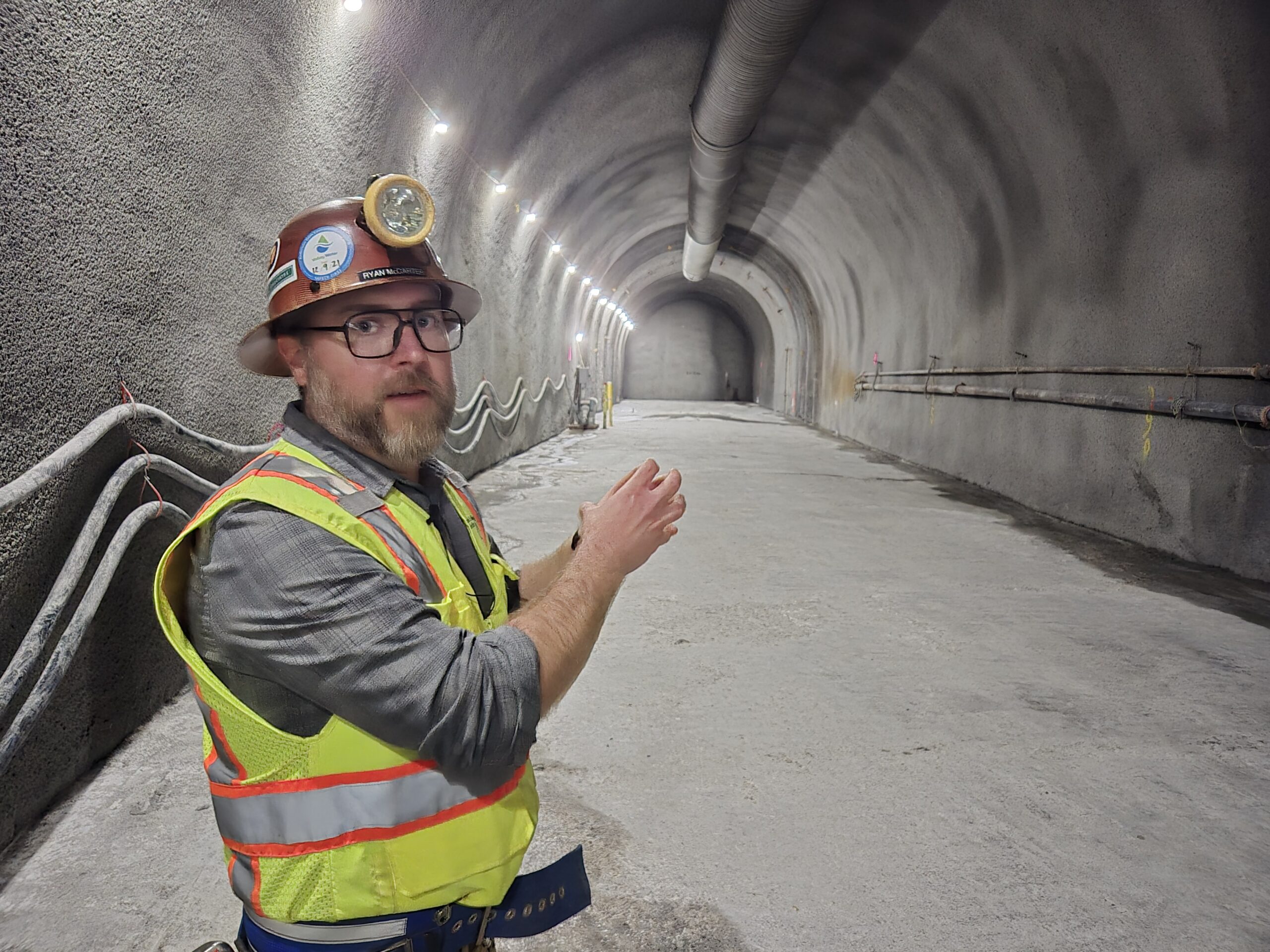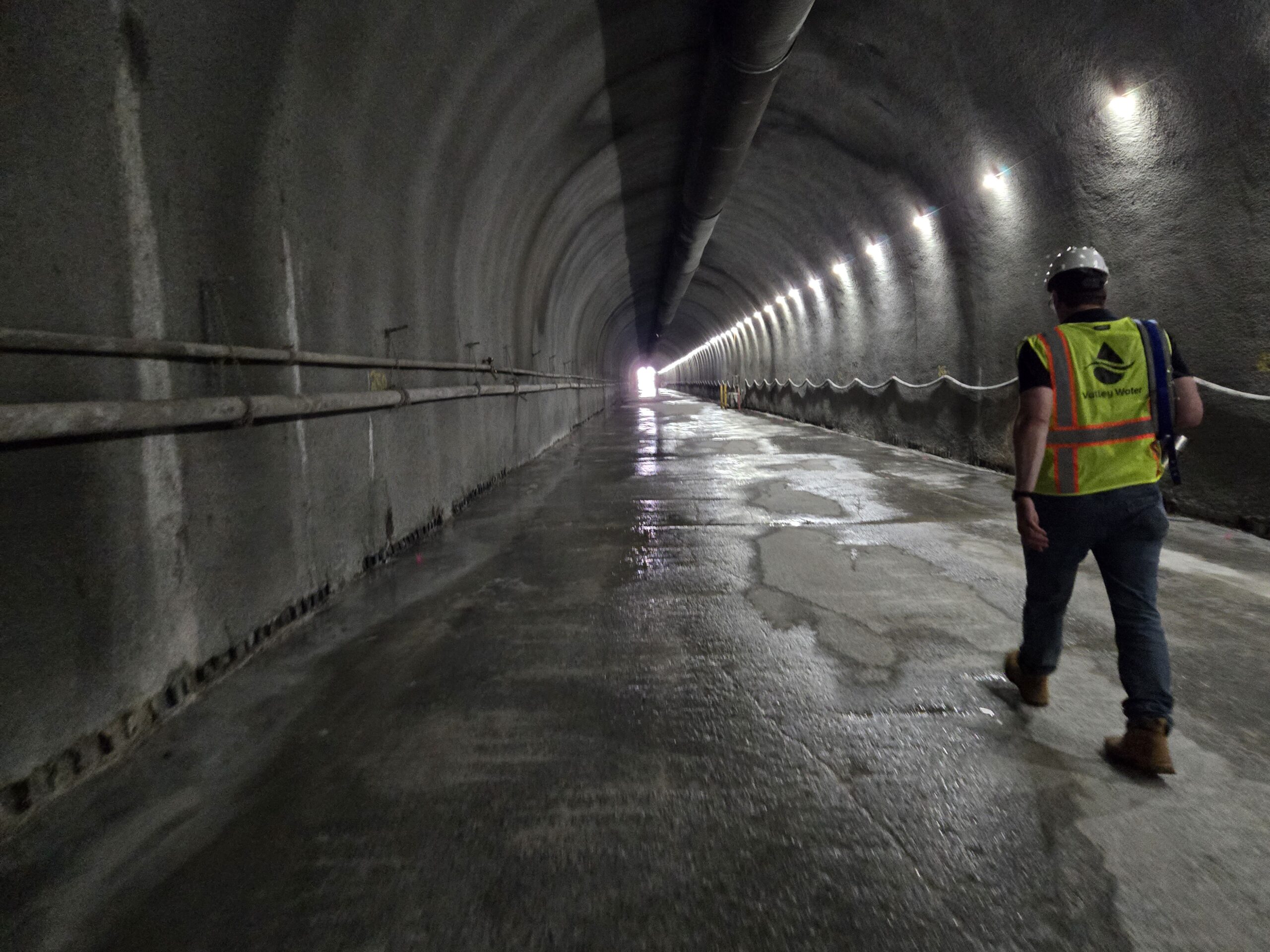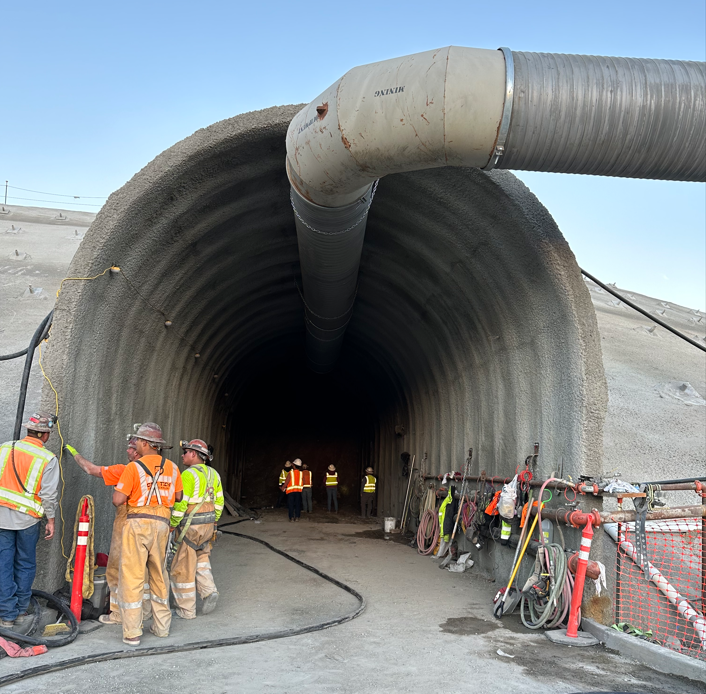$2.3B project is “top priority” for Valley Water
![]()

Photo by Calvin Nuttall
Ryan McCarter, Valley Water project manager, guides visitors in a tour through the newly dug outlet tunnel underneath Anderson Dam.
By Calvin Nuttall
After years of planning and construction, the $2.3-billion Anderson Dam Seismic Retrofit Project will soon reach a critical milestone.
The near completion of its outlet tunnel paves the way for the main phase of the effort to ensure the dam’s safety and protect the region’s water supply in the event of a major earthquake.
Once completed this summer, the tunnel will enable a much higher rate of flow of water out of Anderson Reservoir, 15 times greater than can be achieved with the original outlet tunnel. When completed, the tunnel will be 1,750 feet long with a 20-foot diameter.

Photo by Calvin Nuttall
The government agency overseeing the project, Valley Water gave a May 10 tour of the tunnel to media and elected officials including John Varela, director of Valley Water District 1, which includes the South Valley.
“This project is Valley Water’s top priority,” he said. “Once completed, it will help ensure public safety, protect our regional water supply, and provide environmental benefits for future generations.”
Valley Water needs additional funds to pay for the seismic retrofit of Anderson Dam as well as other big projects. At its May 24 meeting, its board of directors passed a rate increase by a vote of 6-1, with Director Rebecca Eisenberg voting no.
People are seeing costs rise for everything in their lives, from energy, groceries, cars, gas and housing, and Valley Water is seeing those same increases for its water supply infrastructure projects, including the Anderson Dam Seismic Retrofit Project, said Matt Keller, a Valley Water spokesperson.
“Smart investments in water infrastructure and technology today remain the most cost-efficient way to ensure Santa Clara County has enough safe, clean water for every person, business, and farm now and into the future,” he said.
Non-agricultural customers in South Valley will see increases of 6.6 percent for groundwater in Zone W-5, an average household increase of $1.22 per month; 14.2 percent for groundwater in Zone W-7, an average household increase of $3.20 per month; and 8 percent for groundwater in Zone W-8, an average household increase of $1.10 per month. In the northern part of the county, customers will see an increase of 12.9 percent for groundwater, an average household increase of $8.78 per month.
Farm industry customers in all zones will see their rates go up from their current 2023-2024 charges of $36.85 per acre-foot to $39.80 per acre-foot.

Photo by Calvin Nuttall
Built in 1950 and named after the first president of the water district, Leroy Anderson, the dam is a 235-foot-tall earthen structure that holds 90,000-acre feet of water when its reservoir is full. That’s more than the other nine reservoirs in Santa Clara County combined.
Anderson Dam was found by geological studies conducted in 2016 to be seismically unsafe in the event of a major earthquake. If a tremor of magnitude 7.25 or greater occurred on the nearby Calaveras Fault, it could cause the dam to rupture and send a 30-foot “wall of water” downstream that could cause devastation in Morgan Hill, San Martin and Gilroy and flood as far away as San Jose and Monterey.
“Projects like these, the community notices more when they don’t work than when they do,” said Cindy Chavez, Santa Clara County supervisor. “If there was a failure in this dam the impact would be immediate to the people who live here. It would be incredibly dangerous to human life.”
In February, work crews completed 80 percent of the tunnel using conventional excavation methods. The remaining estimated 350 feet of the tunnel will be completed using a purpose-built micro-tunnel boring machine, a remotely operated device that will breach the lake floor underwater, in a procedure referred to as a “lake tap.”
“It is an enclosed machine that will come right out into the water,” said Ryan McCarter, project manager. “It installs pieces of pipe behind it, and they push the machine forward as it advances. We’ll reach the water this summer.”
A prerequisite to the main project, the outlet tunnel will allow Anderson Reservoir to be maintained at a safe level by diverting water during the deconstruction of the dam, McCarter said. The existing tunnel is insufficient to remove lake water fast enough if it accumulates quickly during a major rain event.

Photo courtesy Valley Water
The western end of the outlet tunnel on Anderson dam while under construction in 2023. When complete it will be capable of releasing water 10 times faster than in the past.
“When storms stack up and we can’t empty the reservoir down to allow the space for the next storm, that’s when we run into issues,” he said.
Alongside their efforts to complete the outlet tunnel, Valley Water crews are also hard at work constructing a diversion outlet structure. It will help to dissipate the energy of the water coming through the outlet in the event of an emergency release, such as during an earthquake or major flood event. Slowing the water in this way will mitigate damage to property and wildlife along Coyote Creek downstream of the reservoir.
“I’m talking about 6,000 cubic feet per second (about 45,000 gallons),” McCarter said. “That is basically a river flow coming through this section. What this structure does is slow down the energy of that water so that it can flow into the creek at a slower pace.”
In winter 2017, several weeks of seemingly non-stop rain filled Anderson Reservoir to full capacity. That caused the water to peak and tumble over the dam’s spillway in mid-February. The intense power of 22,400 gallons per second suddenly filling the Coyote Canal caused a levee north of Cochrane Road to fail. The resulting flood hit northbound U.S. 101, stopping vehicles. The resulting freeway gridlock during the morning commute reached to Gilroy and farther south.
The catastrophic flood hit San Jose neighborhoods along the inundated Coyote Creek, including Rock Springs, Naglee Park, and the South Bay Mobile Home Park. The flood displaced about 14,000 residents and caused an estimated $100 million in damages. Many residents who suffered financial hardship due to the flood filed lawsuits against Valley Water. After a four-year legal battle, the water district agreed to settle the lawsuits in June 2022 by paying $8.25 million to the flood victims.
The retrofit project has been a collaboration between government agencies including Valley Water, Santa Clara County, the Federal Energy Regulatory Commission, the California Division of Dam Safety, and others.
“This is many years from being completed, but I do want to say thank you to everyone who has worked to get us this far,” Chavez said. “These are very complex projects and they’re important and require the highest level of professionalism, and I’m so grateful to see it.”
 The retrofit project is expected to be completed in 2032. As Valley Water’s largest surface water storage facility, returning Anderson Reservoir to service is critical to the district’s overall strategy to meet county water needs.
The retrofit project is expected to be completed in 2032. As Valley Water’s largest surface water storage facility, returning Anderson Reservoir to service is critical to the district’s overall strategy to meet county water needs.
“I know that you all know how big this project is, but I just want to put this in perspective,” Chavez said. “Anderson is so large that every one of the other nine reservoirs could fit in it. What that means is that the work of the folks that are working on this, from engineering to construction, are dedicated and important to making sure that we have a safe, healthy project.”
The push to reach the recent 80 percent milestone of the outlet tunnel came after months of concerted effort, working crews around the clock to push the project toward on-time completion.
“On some days, there are about 100 workers on-site,” McCarter said. “We also have a lot of engineers, planners, and scientists working on this around the clock (not necessarily on-site). The tunnel excavation was a very aggressive schedule, they worked day and night shifts six days a week for the past year and a half or so. It was very aggressive to get this work done on time.”
Calvin Nuttall is a Morgan Hill-based freelance reporter and columnist.






